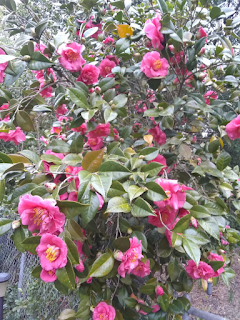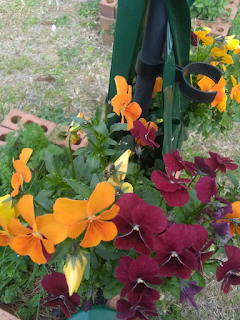Welcome
back to another episode of Lost in the Farmers Market. This episode was delayed mainly due to my own
indecision on the topic. Current events are all about the Covid-19 viral pandemic
and it’s kind of hard to ignore world events even here at LITFM. But how does
it even relate to a garden blog; well honestly the request by our government to
curtail all extraneous travel and to largely stay home has many worried about
what amounts to cabin fever. Of course my answer for the issue was to go out
and garden, I mean that’s still ‘staying at home’ isn’t it? I proposed the
Pandemic Garden Challenge last week during the sustainable Neighbors online
meeting, and all of you readers out there are welcome to join in. Here’s how
this works, instead of sitting around in your house, go out to your yard, or
your community garden plot or any place you can garden and go at it. If you can
join our meeting or are able to access the Sustainable Neighbors meetup.com
page send in photos to the weekly meeting event posting of what garden stuff
you did. At the least we will all get inspired by efforts underway and we’ll
all be getting some sunshine and some exercise. For those of you who are sick
and under self-quarantine, you can participate but take it easy, and remember,
your yard is part of your home. There would be nothing better than to see what
all you gardeners come up with, and don’t worry, there will be photos here of
what has been done and what will be done but now just a brief bit about
survival foods for your garden.
The
term ‘Survival Food’ sounds kind of grim doesn’t it? However if we take away
any concept of post-apocalyptic musings it’s simply a catch-all term for
certain food crops that perform well in less than favorable conditions.
Considering that a lot of what we see in the produce aisle at the supermarket
is the product of conventional agricultural practices. A lot of those foods
have been bred to a point that while they are attractive to the eye and
moderately nutritious, they practically require the use of fertilizers,
herbicides and pesticides just to reach maturity and a reasonable edible state.
Survival foods can do this without all that fuss.
1.
Amaranthus
viridis
– Amaranth aka Callaloo. Amaranth is most famous for its ability to develop
roundup resistance (Palmer Amaranth) and it’s adaptability to a wide range of
soil conditions, rainfall levels and its ability to take heat like no other
leafy vegetable. The amaranth family itself is surprisingly versatile, and for
the most part edible, inevitably you may find wild amaranth amongst your weeds.
As far as nutrition goes Amaranth is a strong source of Manganese, Magnesium,
Phosphorous, Iron, Selenium and Copper while having a fair amount of carbs per
cup of cooked leaves.
2.
Chenopods – Strawberry Blite,
Wild Basil and many others. The name Chenopod sounds like something ripped
right out of a strange science fiction movie, but it is a shorthand name for a
group of plants collectively called the Goosefoot family. The most famous members
of the family are Beets, Swiss Chard and Spinach. The family got its name from
the shape of the leaves on Lamb’s Quarters (Chenopodium
album) an edible ‘weed’ but that isn’t all. One famous grain is also a
member of this family, and you would know it as Quinoa (Chenopodium quinoa). In short,
there is a chenopod in every level of the food system ranging from forage food
to the produce aisle at the supermarket and realistically in an age of food
insecurity this variable family is one of your safest bets.
3.
Salsola
komarovii –
Saltwort. Technically the Saltworts in part or in whole are relatives of the
Amaranth family but their unique nature and differing culture standards have earned
them a separate listing. Saltworts are known for their crunchy texture and
somewhat salty flavor but also for their
ability to survive in salt marshes which makes them quite a useful survival
food. Saltworts are rich in Vitamin A, Vitamin E, Folate, Vitamin C, Vitamin K,
Potassium, Calcium, Magnesium, Iron, Copper and Manganese. There are a ton of
other edible members in this family to meet your preference
4.
Claytonia – Miner’s Lettuce.
Miner’s lettuce is name such because it was a forage food near mines and tended
to supplement already lacking diets at a time when fresh greens might be
scarce. It is fairly nutrient dense as it contains significant amounts of
Vitamin C, Vitamin A, Iron beta-carotene (the stuff that makes carrots orange)
and a noticeable amount of protein. Miner’s lettuce is definitely something you
as a gardener should consider.
5.
Portulaca – The Purselane
Family. Purselane is one of those plants that has been cultivated from the wild
into showy forms that often are thought of as purely ornamental. The reality is
that even the Moss Rose annuals you buy at the garden center are 100% edible
and are one of the few true succulents on this list. Purselane is rich in
Potassium, Magnesium, Calcium, Phosphorous and Iron making it a good supper
time spinach substitute after even the Swiss Chard has quit. Purselane will
self-sow so seed collection isn’t as urgent.
6.
Stellaria media – Chickweed.
For you regular readers you knew this was coming. Chickweed is a spring annual
that will propagate itself as long as you leave some of the prior springs
plants around long enough to go to seed. It can be eaten as a salad green or
cooked like spinach.
7.
Alliaria petiolata – Garlic Mustard.
Oh yeah, this weedy member of the cabbage family tastes like a mix of garlic
and mustard greens and practically propagates itself. The leaves are best eaten
when young but the flowers are fully edible and a strong pollinator attractant
so win-win for you. Garlic Mustard is has quite a bit of fiber, Vitamin A,
Beta-Carotene, Vitamin E, Vitamin C, Calcium, Iron, Zinc, Manganese, and
Copper. The best part is that Garlic mUstard has a high concentration of
Omega-3 fatty acids.
8.
Viola sp. – Violets. I
bet you didn’t see this one coming did you? The flowers of violets are known to
be edible and during the Victorian era were candied as a special treat. What
you didn’t know is that the foliage is completely edible, and if made into a
high potency tincture it can act as a mild pain reliever. The annual Violets
and Jonny jump ups you get at garden centers will self-sow if you let them. The
Violets you find in your lawn that are perennial are also viable as a food
item.
9.
Lamium amplexicaule – Henbit. I
wasn’t going to leave Henbit out of this; it’s one of my long-term favorites. Looking
at the scientific name here will tell you something, Lamium is the scientific
name of the Dead-Nettle family, which ultimately falls under the Mint family
heading. This tells you that it is a spreading plant that may root wherever its
stems touch the ground. Its flowers will be born in whorls and that pollinators
love it. It may also be preferred by honey bees. In terms of food though it is
high in fiber, Iron and is noted as an anti-rheumatic.
Now
the above isn’t an exhaustive list as there are many edible forage/survival
plants out there. However I skipped over anything that requires cooking in
changes of water or that had any unfortunate gastrointestinal consequences if
you eat too much in a serving. Obviously no one wants to begin the apocalypse
with crippling diarrhea; I mean…burning up all that toilet paper you horded
during the current pandemic within the first few months is pretty awful. So
with the survival foods covered let’s move on to some delightful photographs.
 |
| At a certain point due to age and exposure to moisture carrots sometimes split the core in the middle can be woody while the outer flesh is just fine. |
 |
| The hills might be alive with the sound of music, but my blueberries were alive with the sound of pollinators, literally you can see the flowers vibrating and the buzzing was amazing. |
 |
| Loropetalum chinense var rubrum - Purple Fringe Bush, This is a hardy evergreen bush that is fairly quick growing and care free, makes a great screen. |
 |
| Camellia sasanqua - Winter-blooming Camellia |
 |
| Viola tricolor - Johnny jump up, as noted in the survival food part of this post, pretty and 100% edible! |
 |
| Someone once said plants cant grow through the walls of a peat pot...this Mississippi Brown cotton plant disagrees. |
 |
| Garden Challenge: A few hundred square feet of hedgerow that needed clearing. |
 |
| Garden Challenge: about two hours later, I cut down eight Carolina cherry trees, cut all sorts of Wisteria and now, it looks a ton better and the paths in this section are now accessible. |
With
all that garden goodness covered this is the part of the blog where I have to
advertise for the Fayetteville City Market. Now I know you readers probably
don’t much like advertisements, but by booth at the City Market helps to cover
the costs of running the test garden and literally maintains the Research &
Development budget that is used to bring you the information that has made up
the backbone of this blog. Also, as of
the start of 2019, my booth can now process credit or debit cards thanks to the
acquisition of s a Square reader so your payment options have doubled. With
that said, if you want to get some GMO-free, Organic vegetables, herbs and
fruiting shrubs come on down to the Fayetteville City Market on 325 Maxwell
Street in downtown Fayetteville between the Hours of 9:00 am and 1:00 pm on
Saturdays. Even in bad weather the market goes on though you might have to look
for me under the ‘arches’ of the Transportation Museum’s front entryway.
Plants
& Stuff Available Now:
Food
Plants:
Cabbage, Pak Choi: $3.00
Celery, Tango: $3.00
Kohlrabi, Grand Duke: $3.00
Lettuce, Buttercrunch Bibb: $3.00
Lettuce, Cherokee: $3.00
Lettuce, Reckless Fire: $3.00
Lettuce, Red Parris Island Romaine:
$3.00
Potato, Red Norland: $3.00
Rhubarb, Victoria: $3.00
Swiss Chard, Bright Lights Mix:
$3.00
Tomato, Cherokee Purple: $3.00
Tomato, Chocolate Cherry: $3.00
Tomato, Pink Accordion: $3.00
Tomato, Sweet Thousands: $3.00
Herbs:
Herb, Black Fennel: $3.00
Herb,
Common Sage: $3.00
Herb, Tansy: $3.00
Herb, Cuban Oregano
Ornamental
Plants:
Abutilon
‘Orange Hot Lava’: $4.00
Other
Stuff:
Soup Kits:
$6.00 (last week for these is 3-38-2020)
Coming
Soon:
Castor
Bean, Impala
Castor
Bean, Zanzibar
Chia
Cotton,
Erlene’s Green
Cotton,
Mississippi Brown Lint
Cotton,
Red-Foliated White
Datura,
Black Currant Swirl
Henna
Lemon
Grass
Lupine
Pepper,
Paisila Bajio
Pepper,
Shishito
Pepper,
Hungarian Paprika
Roselle
Tomatillo
Due
to the current Covid-19 situation and the state’s requirement that all citizens
are not to gather in groups of more than ten, the weekly Sustainable neighbors
meeting is online. Please check the sustainable neighbors Meetup.com page for
more info about how to attend our online meeting.
https://www.meetup.com/SustainableNeighbors/
Since
our meetings have an open-door policy you don’t need to sign up for anything or
join anything, you can come on in and join the meetings. If not, you can always
send me questions through this blog or visit the farmer’s market.
This
brings to a close the sixth LITFM post of 2020; stay tuned the next episode
which should be posted on the 3rd of April. There will be more
garden updates and other cool stuff.



No comments:
Post a Comment